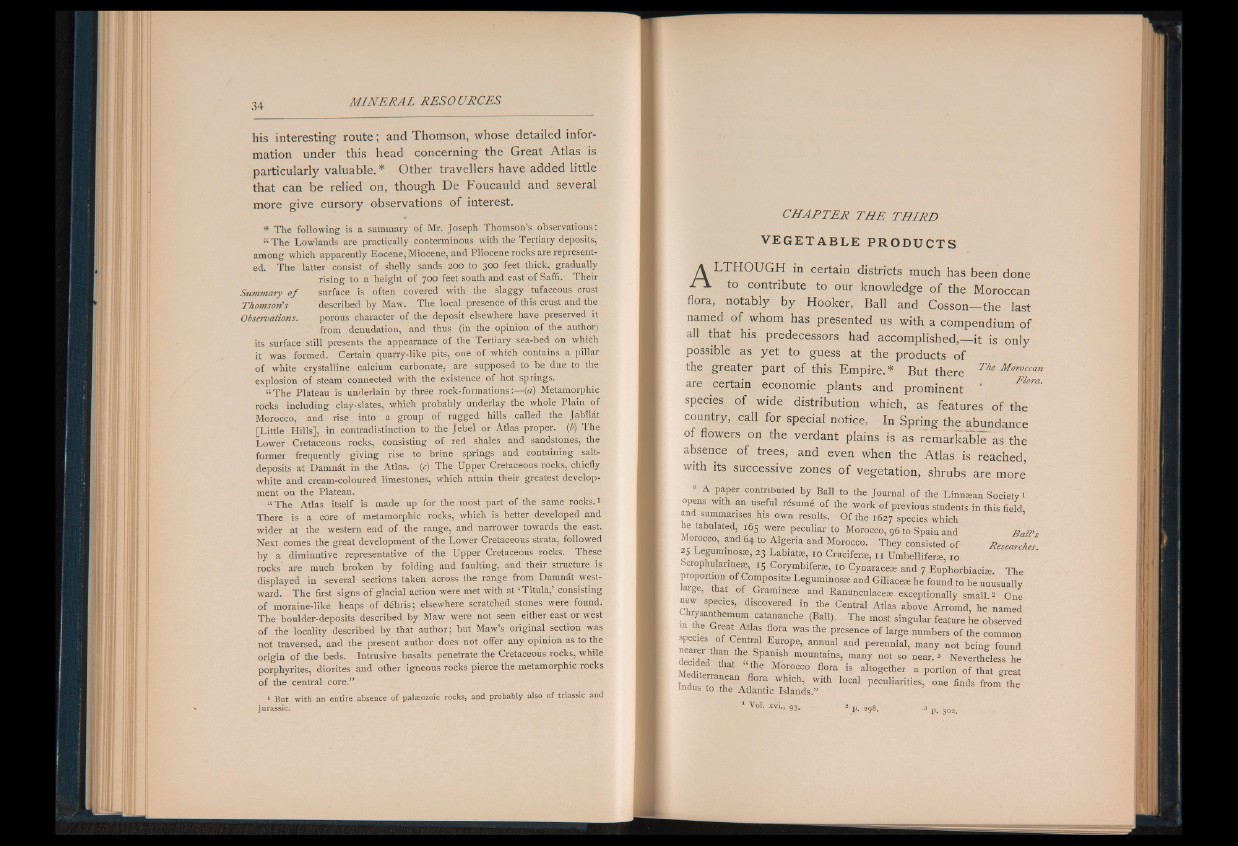
his interesting route ; and Thomson, whose detailed information
under this head concerning the Great Atlas is
particularly valuable. * Other travellers have added little
that can be relied on, though De Foucauld and several
more give cursory observations of interest.
* The following is a summary of Mr. Joseph Thomson’s observations:
“ The Lowlands are practically conterminous with the Tertiary deposits,
among which apparently Eocene, Miocene, and Pliocene rocks are represented.
The latter consist of shelly sands 200 to 300 feet thick, gradually
rising to a height of 700 feet south and east of Saffi. Their
Summary o f surface is often covered with the slaggy tufaceous crust
Thomson's described by Maw. The local presence of this crust and the
Observations. porous character of the deposit elsewhere have preserved it
from denudation, and thus (in the opinion of the author)
its surface- still presents the appearance of the Tertiary sea-bed on which
it was formed. Certain quarry-like pits, one of which contains a pillar
of white crystalline calcium carbonate, are supposed to be due to the
explosion of steam connected with the existence of hot springs.
“ The Plateau is underlain by three rock-formations:— (a) Metamorphic
rocks including clay-slates, which probably underlay the whole Plain of
Morocco, and rise into a group of rugged hills called the Jabîlât
[Little Hills], in contradistinction to the Jebel or Atlas proper, (b) The
Lower Cretaceous rocks, consisting of red shales and sandstones, the
former frequently giving rise to brine springs and containing salt-
deposits at Damnât in the Atlas, (c) The Upper Cretaceous rocks, chiefly
white and cream-coloured limestones, which attain their greatest development
on the Plateau.
“ The Atlas itself is made up for the most part of the same rocks. 1
There is a core of metamorphic rocks, which is better developed and
wider at the western end of the range, and narrower towards the east.
Next comes the great development of the Lower Cretaceous strata, followed
by a diminutive representative of the Upper Cretaceous rocks. These
rocks are much broken by folding and faulting, and their structure is
displayed in several sections taken across the range from Damnât westward.
The first signs of glacial action were met with at ‘ Titula,’ consisting
of moraine-like heaps of débris; elsewhere scratched stones were found.
The boulder-deposits described by Maw were not seen either east or west
of the locality described by that author; but Maw’s original section was
not traversed, and the present author does not offer any opinion as to the
origin of the beds. Intrusive basalts penetrate the Cretaceous rocks, while
porphyrites, diorites and other igneous rocks pierce the metamorphic rocks
of the central core.”
1 But with an entire absence of palaeozoic rocks, and probably also o f triassic and
jurassic.
CHARTER TH E TH IRD
VEGETABLE PRODUCTS
A LTHOUGH in certain districts much has been done
E \ to contribute to our knowledge o f the Moroccan
flora, notably by Hooker, Ball and Cosson— the last
named o f whom has presented us with a compendium of
all that his predecessors had accomplished,— it is only
possible as yet to guess at the products of
the greater part of this Empire.* But there The Moroccan
are certain economic plants and prominent * N°m’
species of wide distribution which, as features of the
country, call for special notice. In Spring the abundance
of flowers on the verdant plains is as remarkable as the
absence o f trees, and even when the Atlas is reached,
with its successive zones o f vegetation, shrubs are more’
• A paper contributed by Ball to the Journal of the Linmean Society1
opens with an useful rSsumli of the work of previous students in this field
and summarises his own results. Of the 1627 species which
he tabulated 165 were peculiar to Morocco, 96 to Spain and B a ll’s
Morocco, and 64 to Algeria and Morocco. They consisted of Researches
25 Leguminosae, 23 Labiatse, 10 Cruciferse, 11 Umbelliferae, 10
Scrophularineae, 15 Corymbiferae, 10 Cynaraceae and 7 Euphorbiaciae. The
W m M I p d l l LeguminoSSe and Giliaceae he found to be unusually
targe, that of Grammeae and Ranunculaceae exceptionally small 2 One
new spemes, discovered in the . Central Atlas above Arromd, he named
Chrysanthemum catananche (Ball). The most singular feature Le observed
soedes o T c 1 f H H i f P1'“ 6“ 6 ° f i l l “ “ nbers o f the common
nearer ,h i Q ¡ S f e 9 Pere“ “ al> maay not being found
decided that m°UDf mS’ many not so near- 3 Nevertheless he
S H B F J ■ H " alt° gether a Potion of that great
iTdus t o T I f ra 1 1 1 Wlth l0Cal us to the Atlantic Islands.” Peculiarities, one finds from the
1 Vol. xvi., 93r . * p. a98. 3 P. 300.